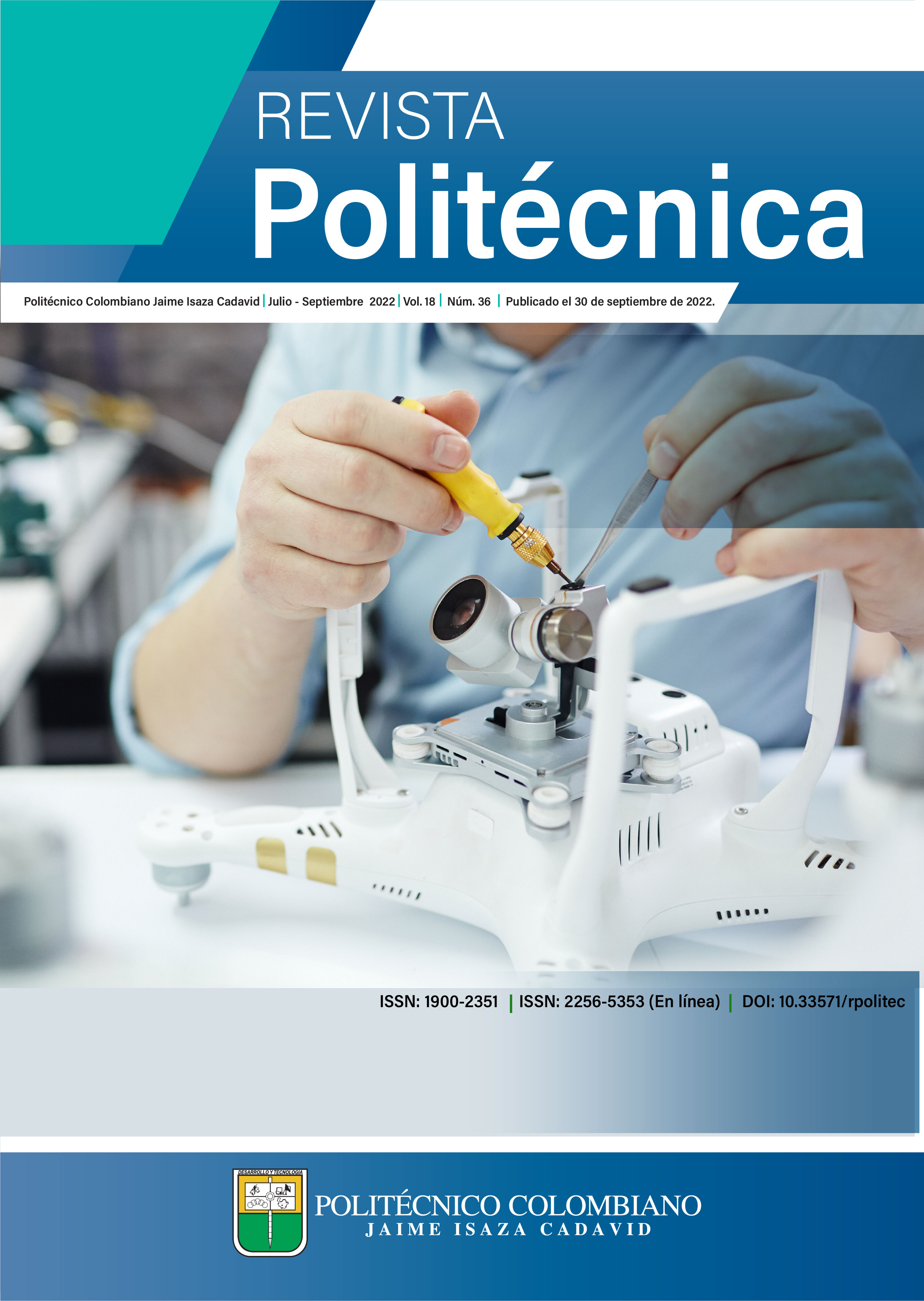Evaluation of physical mechanical properties in concrete pavers made with construction and demolition waste
DOI:
https://doi.org/10.33571/rpolitec.v18n36a1Keywords:
Recycled coarse aggregate; paver; construction and demolition wastes; flexural tensile strength; water absorption.Abstract
In this study concrete pavers replacing natural coarse aggregate with recycled coarse aggregate were manufac-tured. The substitution percentages were 15%, 30% and 45%. The chief characteristics studied for coarse aggregate were particle size, bulk density and specific density. The chief characteristics studied in the pavers were water absorption, density and flexural strength. It was observed that the density of the pavers decreased by increasing percentage of recycled coarse aggregate replacement due to the due to the high porosity of the recycled aggregates. On the other hand, it was found that the pavers with a 15% substitution were the only ones that reached the average flexural tensile strength indicated in the standard. It was concluded that the manufactured pavers can be used in areas with high rainfall or high-water tables, as well as in car parks or sidewalks
Article Metrics
Abstract: 562 PDF (Español (España)): 289 HTML (Español (España)): 125PlumX metrics
References
Sani, R., & Nzihou, A. (2017). Production of clay ceramic using agricultural wastes: Study of properties, energy savings and environmental indicators. Applied Clay Science, 146, 106-114. https://doi.org/10.1016/j.jclepro.2013.11.005
Cabeza, L. F., Rincón, L., Vilariño, V., Pérez, G., & Castell, A. (2014). Life cycle assessment (LCA) and life cycle energy analysis (LCEA) of buildings and the building sector: A review. Renewable and Sustaina-ble Energy Reviews, 29, 394-416. https://doi.org/10.1016/j.rser.2013.08.037
Scrivener, K. L., & Nonat, A. (2011). Cement and Concrete Research Hydration of cementitious materi-als, present and future. Cement and Concrete Research, 41(7), 651-665. https://doi.org/10.1016/j.cemconres.2011.03.026
Kisku, N., Joshi, H., Ansari, M., Panda, S. K., Navak, S., & Dutta, S. C. (2017). A critical review and assessment for usage of recycled aggregate as sustainable construction material. Construction and Build-ing Materials, 131, 721-740. https://doi.org/10.1016/j.conbuildmat.2016.11.029
Hossain, U., Sun, C., Hong, Y., & Xuan, D. (2018). Evaluation of environmental impact distribution methods for supplementary cementitious materials. Renewable and Sustainable Energy Reviews, 82, 597-608. https://doi.org/10.1016/j.rser.2017.09.048
Shi, C., Li, Y., Zhang, J., Li, W., Chong, L., & Xie, Z. (2016). Performance enhancement of recycled concrete aggregate - A review. Journal of Cleaner Production, 112, 466-472. https://doi.org/10.1016/j.cemconres.2011.03.026
Becerra-Duitama, J. A., & Rojas-Avellaneda, D. (2022). Pozzolans: A review. Engineering and Applied Science Research, 49(4), 495-504. https://doi.org/10.14456/easr.2022
Wu, H., Zuo, J., Zillante, G., Wang, J., & Duan, H. (2021). Environmental impacts of cross-regional mo-bility of construction and demolition waste: An Australia Study. Resources, Conservation and Recycling, 174, 105805. https://doi.org/10.1016/j.resconrec.2021.105805
Zhang, J., Ding, L., Li, F., & Peng, J. (2020). Recycled aggregates from construction and demoli-tion wastes as alternative filling materials for highway subgrades in China. Journal of Cleaner Produc-tion, 255, 120223. https://doi.org/10.1016/j.jclepro.2020.120223
Vieira, C. S., & Pereira, P. M. (2015). Use of recycled construction and demolition materials in ge-otechnical applications: A review. Resources, Conservation and Recycling, 103, 192-204. https://doi.org/10.1016/j.resconrec.2015.07.023.
Rahman, M., Imteaz, M., Arulrajah, A., & Disfani, M. M. (2014). Suitability of recycled construction and demolition aggregates as alternative pipe backfilling materials. Journal of Cleaner Production, 66, 75-84. https://doi.org/10.1016/j.jclepro.2013.11.005
Rahman, M. A., Arulrajah, A., Piratheepan, J., Bo, M. W., & Imteaz, M. A. (2014). Resilient Modu-lus and Permanent Deformation Responses of Geogrid-Reinforced Construction and Demolition Mate-rials. Journal of Materials in Civil Engineering, 26(3), 512-519. https://doi.org/10.1061/(asce)mt.1943-5533.0000824
Monrose J., Tota-Maharaj, K., & Mwasha, A. (2019). Assessment of the physical characteristics and stormwater effluent quality of permeable pavement systems containing recycled materials. Road Materials and Pavement Design, 22(4), 1-33. https://doi.org/10.1080/14680629.2019.1643397
ICONTEC (2018). NTC 2017 Adoquines de concreto para pavimentos. Instituto Colombiano de Normas Técnicas y Certificación (ICONTEC)
Kumar, G., Shrivastava, S., & Gupta, R. C. (2020). Paver blocks manufactured from construction & demolition waste. Materials Today: Proceedings, 27, 311-317. https://doi.org/10.1016/j.matpr.2019.11.039
Evangelista, L., Guedes, M., De Brito, J., Ferro, A. C., & Pereira, M. F. (2015). Physical, chemical and mineralogical properties of fine recycled aggregates made from concrete waste. Construction and Building Materials, 86, 178-188. https://doi.org/10.1016/j.conbuildmat.2015.03.112
Lovato, P. S., Possan, E., Molin, D. C. C. D., Masuero, Â. B., & Ribeiro, J. L. D. (2012). Model-ling of mechanical properties and durability of recycled aggregate concretes. Construction and Build-ing Materials, 26(1), 437-444. https://doi.org/10.1016/j.conbuildmat.2011.06.043
Pepe, M., Toledo Filho, R. D., Koenders, E. A. B., & Martinelli, E. (2014). Alternative processing procedures for recycled aggregates in structural concrete. Construction and Building Materials, 69, 124-132. https://doi.org/10.1016/j.conbuildmat.2014.06.084
Published
How to Cite
Issue
Section
License
Copyright (c) 2022 Jhonatan Alexander Becerra-Duitama, Jhonattan Andrés Echeverría-Avella , Paula Andrea Galvis-Echeverría

This work is licensed under a Creative Commons Attribution-NonCommercial-ShareAlike 4.0 International License.


























